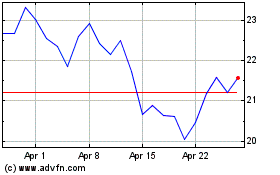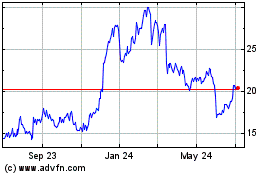By Ryan Knutson
Don Budreski earlier this year noticed a roughly
three-story-tall utility pole pop up across the street from his
Baltimore electronics shop.
"It was just odd," he said of the slender, steel post. "I
thought, 'What are they putting that thing there for?' "
Mr. Budreski had caught a glimpse of a key element of Sprint
Corp.'s plan to improve its network and win back customers:
thousands of sidewalk utility poles.
The Overland Park, Kan., company wants to install low-power
cellular antennas in public rights of way, land typically holding
utility poles, street lamps and fire hydrants. In places where it
can't strap antennas to existing poles, it wants to erect new
poles.
Sprint is primarily working with Mobilitie LLC, a Newport Beach,
Calif., company to build these cellular antenna systems from
California to Massachusetts. Mobilitie has begun installing them,
which it says are typically the size of a briefcase and often
inside boxes attached to the poles.
But the rollout has been delayed as communities confront what
some consider unsightly installations and authorities wrestle with
new regulatory questions. Sprint recently slashed its capital
spending plans for the year as it waits for zoning approvals.
Mobilitie says it has about 1,000 permits approved and will start
large-scale installations once more are in hand.
In the past, wireless carriers built towers of 200 feet or more
that could send signals over large areas to cover as many customers
as possible. Now that more people use smartphones to stream videos
and surf the Web, carriers want to put lower-power antennas closer
to the ground so that fewer people will connect to each one --
resulting in less network congestion.
"It's not a new concept," said John Saw, Sprint's chief
technology officer. "All carriers are trying to 'densify' their
networks." But Sprint's goal is to be "cheaper and faster and more
innovative" than its rivals, he said.
Popping antennas on existing utility poles is something most
carriers are hoping to do. But cash-strapped Sprint aims to take
the concept further than rivals: It is hoping to install as many as
70,000 antennas in the public right of way over the next few years.
By comparison, it has 40,000 traditional antenna sites on towers or
rooftops.
It is a central piece of a strategy devised in early 2015 by
Sprint Chairman Masayoshi Son to improve service while keeping
costs down. Companies can negotiate with a city for one deal that
includes various permits. Mobilitie's Mr. Jabara says building and
operating these so-called small cells costs about $190,000 over 10
years, whereas a traditional tower costs $732,000 because of real
estate rents, power and other costs.
The airwaves Sprint owns are ideally suited for this design
because their high frequency prevents them from traveling long
distances. Rather than string fiber-optic cables to each antenna,
Sprint hopes to link them via wireless connections, further
bringing down costs and speeding deployment.
Analyst Jonathan Atkin at RBC Capital Markets is skeptical,
saying Sprint may only be able to build a fraction of the sites it
wants in public rights-of-way governed by federal, state and local
laws.
Mobilitie's practices in some places have faced local
resistance. It has filed applications under various corporate
names, including the Illinois Utility Pole Authority, NC Technology
Relay Networking, and Interstate Transport and Broadband. It has
used similar-sounding names in at least 30 states.
Joseph Van Eaton, a lawyer who represents municipalities dealing
with the applications, says the names are misleading. "You may very
well end up with some of these applications being granted for
exactly the reason why they like these names -- it sounds
official," he said.
Mobilitie is willing to modify its applications to avoid being
disruptive, says Chief Executive Gary Jabara. "It's more important
to be a good citizen" than to move quickly, he said. "You have to
do the right thing."
Mr. Jabara says the names also make it easier for local
officials to understand the status of his firm. The company is a
registered utility and those business names helps reflect that
status, he says. "In some states it's more comprehensible for a
jurisdiction to work with an authority," he said. In the future,
the company will most often use the name "Mobilitie" in dealings
with local officials, he said.
In Salem, Mass., Mobilitie applied last fall to install antennas
on seven poles. After some residents expressed concerns over the
look of the antennas, the company withdrew three applications and
agreed to camouflage the other four.
In Baltimore, Mobilitie was fined $5,000 for failing to get
proper permits for the temporary pole across from Mr. Budreski's
shop, which was taken down after a few days. The company since has
received approval to attach equipment to 14 poles across the city.
It will pay Baltimore $70,000 for pole attachment rights in the
first year of the deal. Mr. Jabara says that amount is unusually
high, and many places charge less than $50 a year per pole.
Mr. Jabara says such incidents were inadvertent mistakes.
Sprint's Mr. Saw says his company is committed to being patient and
making sure municipalities are comfortable with its plans.
"We're not surprised that sometimes you will run into opposition
in certain jurisdictions," Mr. Saw says. " 'Not in my backyard' has
been around for a very long time."
Write to Ryan Knutson at ryan.knutson@wsj.com
(END) Dow Jones Newswires
June 07, 2016 18:18 ET (22:18 GMT)
Copyright (c) 2016 Dow Jones & Company, Inc.
SentinelOne (NYSE:S)
Historical Stock Chart
From Mar 2024 to Apr 2024

SentinelOne (NYSE:S)
Historical Stock Chart
From Apr 2023 to Apr 2024
